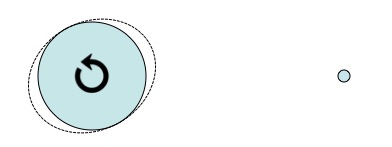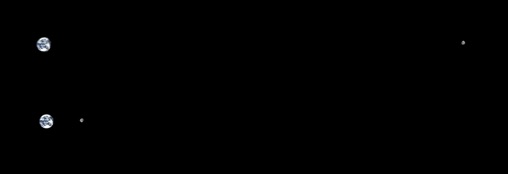The original question was: I know the Moon is getting further away because tides/friction/conservation of angular momentum. This video claims Phobos is getting closer to Mars because of tidal forces, what gives? Obviously no oceans to drag around but what else?
Physicist: A moon causes the material of the planet under it to distend toward it (and away, which is why there are two tides). This is especially obvious on Earth where the water is free to move a lot more than the ground. However that bump takes a little while to relax and, because planets turn and moons orbit, that bump is never exactly under the moon.

The tidal bulge created by a moon doesn’t stay directly under that moon, either because the planet is turning, because the moon is orbiting, or both. This is really, really not to scale.
Because the Earth spins in the same direction that the Moon orbits, our bump leads the Moon a little. If the Moon orbited in the opposite direction, or even orbited so fast that its orbit were faster than the Earth’s spin, then the bump would trail the Moon.
The bump itself has mass and therefore a little extra gravity. If it leads the moon, then the moon speeds up because it’s getting a tiny, tiny extra pull in the direction its orbiting. Speeding up causes things in orbit to assume higher orbits, which we often and not-quite-accurately describe as “drifting away”. Our Moon gets a couple cm farther away every year.
On the other hand, if the tidal bump trails behind a moon, then that moon is slowed down and drops lower as a result. Phobos’ orbital period is about 8 hours (it’s already very low), and Mars’ day (a “sol“) is about as long as ours, so the bump Phobos creates necessarily trails behind it. As a result Phobos is slowly dropping and will eventually impact Mars. Mars is going to have a really bad sol in about 50 million years.
But raising moons consumes a lot of energy and that energy has to come from somewhere. The same tiny pull that the Earth applies to the Moon to speed up its orbit is applied to the Earth to slow down our day. When the Moon formed around 4.5 billion years ago, it about 15 times closer to the Earth (give or take) and a day was only about 6 hours long. Back then a full moon would have provided about 200 times as much light and solar eclipses would have blacked out swaths of the Earth’s surface nearly the size of Australia.
Our Moon has more than 7 million times the mass of Phobos, so Phobos doesn’t have nearly as pronounced an impact on the spin of Mars.
We live in a remarkably unlikely time, when the size of the Moon in the sky perfectly matches the size of the Sun. In fact, since the Moon’s orbit around Earth is a little elliptical, the Moon is sometimes a little smaller and sometimes a little bigger. We live on the only planet that gets to see both annular and total solar eclipses. But see a total eclipse while you can; in a few million years we’ll be stuck with only annular eclipses. Sucks to be you, unforeseeable future generations!








From what you say, I imagine that the tidal bulge caused by the moon would also affect small satellites in orbit around the earth. Suppose we put a satellite in, say, a 36 hour orbit around the earth, so farther out than the geosynchronous ones. Would it then slowly speed up and move away from the earth. And would any satellite inside the geosynchronous ones, but well above the earth’s atmosphere, slow down and move closer and closer to the earth.
“and not-quiet-accurately” – I think you meant quite and not quiet.
@Andrew Hall
I did! Thanks for catching that.
Will the Earth eventually slow down so much that the bulge falls behind and starts drawing the Moon in closer? Will it oscillate, crash in to the Earth, or will the expanding Sun just devour it all first?
How low can Phobos get and still remain in a stable (as in not crashed yet) orbit? Would there be an epic final day / month / year / decade of fireworks?
This creates problems because the Earth did not have any notable oceans until a good approximately 1Billion years after the moon was formed/captured. And that’s just one of the many paradoxes caused by our current lunar mechanics theories and lunar genesis hypotheses.
Oh and what do you think about prepostrous idea that one planet in the solar system is formed with a 6 hour day when all the other terrestrials have at least a modest 24 hour day, or like mercury and Venus both have days nearly matching their orbital periods.
But the Earth just happens to have some absurdly fast spin?
Furthermore, the inverse square law applies to gravitation and subsequent rotation so you are claiming that an orbit 1/15th the current radius would have only a 1/4th impact on the rotational period?
There is a significant discrepancy in the claim the moon has a certain periodicity…physicists I think have “fixed” the numbers to make sense of observation and not actually used real mathematics to prove their beliefs.
The fact is that geologists claim they found rocks with tidal periods as short as 3 hours suggesting an early 6 hour period of time. Physicists, astrophysicists, etc, by their nature, use observation to formulate theory and fit that to their mathematical models.
If you start from a purely mathematical approach you’d, likewise, see that the Moon cannot both be 1/15th its orbit and the Earth only 1/4th its rotational period. One of those figures by the inverse square law must be wrong.
Tides pull on rocks, too, not just ocean.
Hi IDNeon – It seems to me that if the Moon were formed by a large body striking the Earth that could have sped up the Earth’s rotation. I think this is independent of your problem with reconciling 1/15 the size of the Moon’s orbit with 1/4 the rotational period of the Earth. I haven’t tried to work this out, but I think you would just estimate the net angular momentum for that case and also for today and see if they are roughly comparable.
Was that what you did?
I get why the there is a tidal bulge, but I’m not sure why there is a bulge away from the moon on the opposite side of the earth. The entire earth is subject to the pull of the moon (though the far side less so). Wouldn’t the deformation be more elliptical (egg like instead of football shaped)?
@Glenn: The moon’s gravitational field affects different parts of Earth differently. In particular, there’s a weaker pull on the far side of Earth, a stronger pull on the near side, and for the parts of Earth that aren’t on the line through the centers of Earth and the moon, the moon pulls them slightly toward that line. I do think the overall effect of this deformation, not accounting for rotation, would turn a sphere into an oblong spheroid. I’d need to see the math in order to verify this conclusion, though.
You’re right: tidal forces wouldn’t make a sphere pointy like an American football.